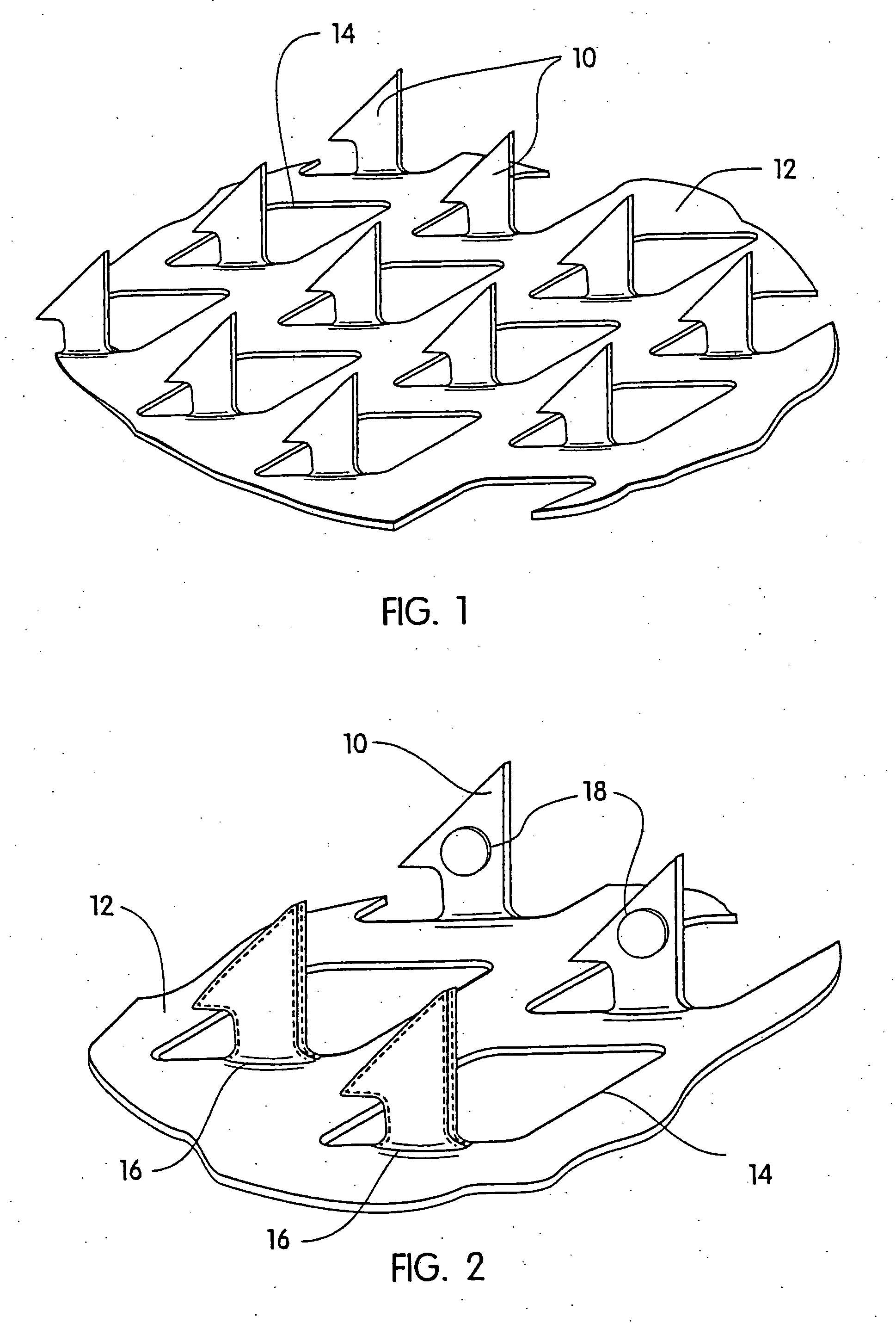Transdermal drug delivery devices having coated microprotrusions
a technology of microprotrusions and transdermal drug delivery, which is applied in the direction of pharmaceutical containers, packaging foodstuffs, packaged goods types, etc., can solve the problems of poor patient compliance, many drugs such as aspirin have an adverse effect on the digestive tract, and many medicaments are completely ineffective or have radically reduced efficacy
- Summary
- Abstract
- Description
- Claims
- Application Information
AI Technical Summary
Problems solved by technology
Method used
Image
Examples
example 1
[0054] A coated microprotrusion device for transdermally delivering desmopressin was prepared in the following manner. An aqueous desmopressin solution having a concentration of 300 mg / ml was prepared by adding desmopressin monoacetate salt (sold by Diosynth, Inc. of Des Plaines, Ill.) to sterile distilled water. Tritium labeled desmopressin was added to the desmopressin solution as a marker. A titanium microprotrusion member of the type illustrated in FIG. 1 was used. The microprotrusion member had a circular shape (1.16 cm diameter sheet with an area of 2 cm2), microprotrusions with a length of 360 μm, and a microprotrusion density of 190 microprotrusions / cm2. The microprotrusion member was immersed briefly in the aqueous desmopressin solution and allowed to dry overnight at room temperature. This procedure resulted in a desmopressin coated microprotrusion member having a coating containing desmopressin in the amount of 150 to 250 μg / cm2 of the sheet.
[0055] Delivery kinetics stud...
example 2a
[0056] A second experiment was performed on hairless guinea pigs (HGPs). All animals wore a system identical to those previously described in Example 1. One group of animals (Group A) wore a system for 1 hour. In two other groups (Groups B and C), the microprotrusion device was removed 5 seconds after application. In Group B, the treatment site was immediately washed after removal of the system. In Group C, the treatment site was not washed but was occluded with an adhesive backing for 1 hour following system removal. The average amounts of desmopressin delivered to the animals in Groups A, B and C are shown in FIG. 4. Group B (5 second delivery and immediate washing) resulted in an average delivery of about 5 μg desmopressin. Group C (occlusion following 5 second application) did not increase significantly the amount delivered to Group B. Group A (one hour delivery) resulted in an average of 18 μg desmopressin delivered. These results indicate that keeping the coated microprotrusio...
example 2b
[0057] The feasibility of coating a microprotrusion array with the drug desmopressin was evaluated. In these studies the coating was limited to the tips of the microprotrusions. A number of microprotrusion arrays (S250 Ti, microprotrusion length 250 μm, 321 microprotrusions / cm2, 2 cm2 disc) were tip coated using the device described in a United States provisional patent (Ser. No. 60 / 276,762, filed 16 Mar. 2001) using a 40 wt % desmopressin acetate solution spiked with 3H desmopressin. Analysis revealed that each microprotrusion array was coated with 187±30 μg desmopressin. SEM examination revealed that the coating was present as a glassy amorphous matrix with good uniformity of coating from microprotrusion to microprotrusion. The coating was limited to the first 115 μm of the 250 μm microprotrusion. The coating was found unevenly distributed on the microprotrusion itself. Most of the solid coating appeared to be located in circular domed regions of the coating called a cap, centered...
PUM
| Property | Measurement | Unit |
|---|---|---|
| viscosity | aaaaa | aaaaa |
| solubility | aaaaa | aaaaa |
| solubility | aaaaa | aaaaa |
Abstract
Description
Claims
Application Information
 Login to View More
Login to View More - R&D
- Intellectual Property
- Life Sciences
- Materials
- Tech Scout
- Unparalleled Data Quality
- Higher Quality Content
- 60% Fewer Hallucinations
Browse by: Latest US Patents, China's latest patents, Technical Efficacy Thesaurus, Application Domain, Technology Topic, Popular Technical Reports.
© 2025 PatSnap. All rights reserved.Legal|Privacy policy|Modern Slavery Act Transparency Statement|Sitemap|About US| Contact US: help@patsnap.com



